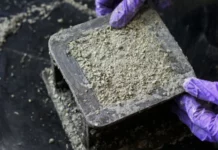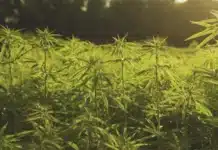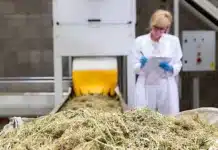It will likely be years before anyone starts seeing fields of commercial hemp growing in New York or any other state.
But research on the crop in the Empire State has revealed some interesting findings: You can get a lot of yield per acre, and birds seem to like it a lot.
That’s according to Larry Smart, horticulture professor at Cornell, who talked about hemp at the New York Farm Show.
The 2014 Farm Bill authorized hemp pilot research programs. In 2016, 15 states, including New York, approved hemp research. That year, 9,770 acres of hemp were grown nationwide, according to Smart. In 2017, more than 25,500 acres of hemp were grown in 34 states.
Smart said that hemp was widely cultivated in colonial America in the 1700s, including by Thomas Jefferson. Production grew gradually until its heyday during World War II, when the federal government funded its planting.
“After the war, hemp declined,” Smart said, “and by the mid-50s, hemp was replaced by synthetic fibers.”
Though hemp lacks the psychoactive properties of the similar marijuana, its cultivation was banned in 1970 by the Controlled Substance Act.
Last year, Cornell researchers planted in 4-by-20-foot plots with four replicated plots per site. They planted with a small plot cone seeder at the rate of 20 to 60 pounds per acre. The plants were harvested using an Almaco small plot combine. Smart said the objectives were to evaluate stand density, flowering date, flower sex, plant height, diseases and insects, biomass yield, grain yield, fiber yield, and quality components.
Six hemp cultivars originating from France, Ukraine, Poland, Canada and Italy were planted, he said. The researchers used land on Cornell farms in Ithaca, Geneva and Freeville.
“Last year was a very wet year, so July planting was not ideal,” he said.
Planting later resulted in lower yields, he said. The plots planted June 9 and harvested 74 days later yielded twice as much as the plots planted June 23 and harvested 76 days later.
However, Smart attributes the lower yields to poor soil health.
“The top cultivar was over 2,300 pounds per acre,” he said. “That demonstrated the impact of site quality for yield.”
The average yield per acre was 1,400 pounds.
The researchers also lost some of the plants to birds.
This year, researchers will evaluate cultivars in Chazy, in the North Country, and in Riverhead on Long Island.
“We hope to capture the latitude variances of New York,” he said.
Smart said that he wants to establish certified seed production in the state as well as initiate a breeding program for New York cultivars. That would include building a germplasm collection through collaboration, learning crossing methods, developing a molecular marker system, refining high-throughout phenotyping, developing genetic maps, and developing marker assisted and genomic selection.
At that point, he said, Cornell could release cultivars adapted to New York.
Smart said many things need to happen before hemp takes off in New York state, including evaluating cultivars, identifying grower interest, evaluating potential markets and processors, modeling costs of production, educating growers and processors on hemp, establishing local seed production, and establishing a long-term hemp breeding program.
Growers would also have to be educated on the various disease risks for hemp, including leaf spot, gray mold, white mold — especially when rotationally planting soybeans or other legumes — and Fusarium. Pests include tarnished plant bug, potato leafhopper, soybean looper and thirps.
Smart said no public labs exist in New York to comply with testing hemp for the maximum 0.3 percent threshold of phencyclidine (PCP) and Delta-9-tetrahydrocannabinol (THC), which is set by the New York Department of Agriculture & Markets.
Though Cornell doesn’t have plans to open such a facility, Smart is hopeful that testing labs will soon open in New York. He added that out-of-state testing by an independent lab would satisfy the ag department’s requirements.
In addition to industrial use as a fiber, Smart said hemp could be used as fodder since it offers 27 percent protein and 35 percent oil, both beneficial for animals.
Hemp is also balanced in omega-6 and omega-3 fatty acids.














